High-Q RF Coil Construction Techniques
Serge Stroobandt, ON4AA
Copyright 2007–2016, licensed under Creative Commons BY-NC-SA
- Home
- Antenna Components
- RF Coil Construction
Construction
A couple of radio amateurs have put some nice pictures on the web that result to be very instructive in explaining how to construct high-Q loading coils:
- Mark Peterse, PA3HMP came up with an elegant design for the trap coils of his wire dipole antennas, solely based on standard PVC tubing.
- Phil Salas, AD5X mastered the art of plumbing water pipe bi-conical compression couplings and nipples together to build sturdy loading coils supported by nylon edge rims. Described here, here and also here.
- Stephen J. Babcock, VE6WZ took a different approach using cable ties and red insulating varnish.
- Theo Bemelmans, ON4AEK - OT4A had this wonderful idea of making high-Q coils out of pure-copper brake pipe. 25ft(7.62m) rolls are available in several diameter gauges.
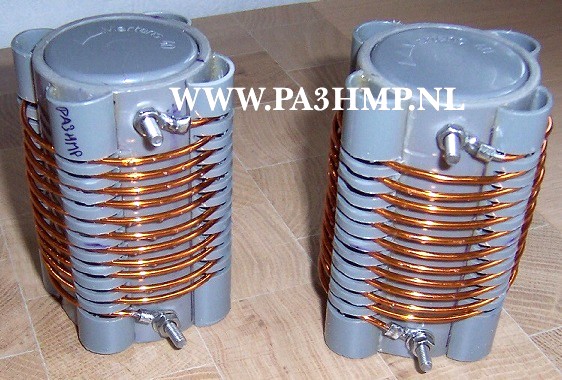
Trap coils by PA3HMP
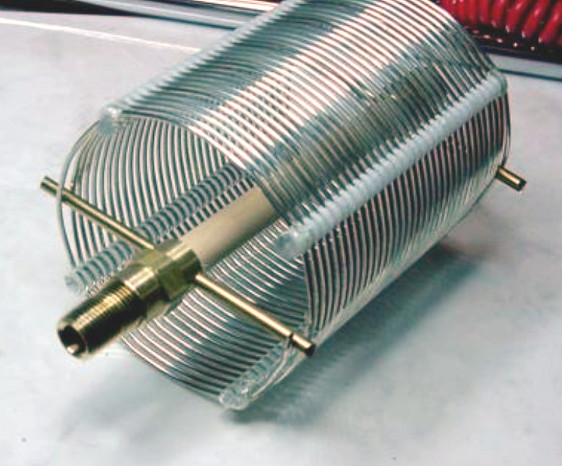
Home-made coil by AD5X
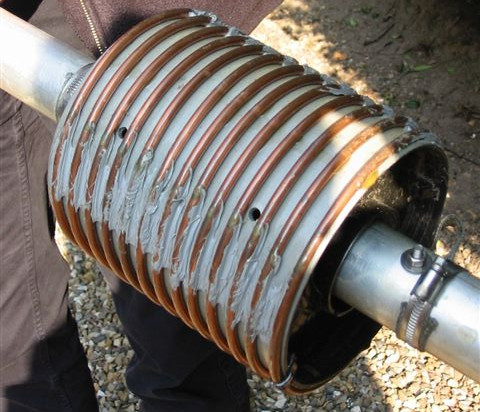
Brake pipe coil by ON4AEK
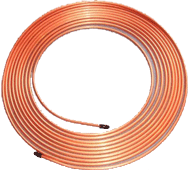
Copper brake pipe
| (inch) | (mm) |
|---|---|
| 3/16 | 5 |
| 1/4 | 6 |
| 5/16 | 8 |
| 3/8 | 10 |
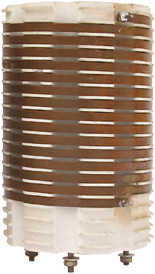 copper-strip coil
copper-strip coil- Another rewarding approach towards reducing losses and therefore increasing Q, consists in fabricating the coil out of copper-strip material instead of round wire or copper tubing.1,2 David Knight, G3YNH, explains the details in his text about the skin and the proximity effect.
For this very same reason, copper-tape on a plastic tube is often employed in the construction of helical antennas.
Dimensions
High-Q coil inductors have something in common: the length of the coil can only be slightly longer than its diameter. In other words, high-Q coils have cube-like dimensions.
If you would like to calculate the inductance L and the quality factor Q of a coil you are about to construct, please, have a go at my on-line inductance calculator!
Silver plating
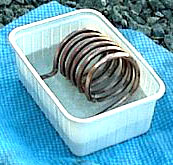 silver plating
silver plating- Copper conductors oxidise after some time. This results in a much reduced conductivity. Silver plated conductors also oxidise, however silver oxide remains highly conductive, unlike copper oxide which is highly resistive. Dirk, ON4AWU and fellow member of the OT5A contest station, developed a very interesting chemical silver plating process.
At a temperature of 20°C (293.15K), silver (Ag) has a resistivity of 15.8·10-9Ωm, which is the lowest of all metals, and a temperature coefficient of 0.0038K-1. Silver[I] oxide (Ag2O) at this temperature has a 500 times higher resistivity of 8·10-6Ωm and a temperature coefficient of 0.004620K-1.3 Nonetheless, silver[I] oxide is still considered to be a conductor, whereas both copper[I] oxide (Cu2O) and copper[II] oxide (CuO) are semiconductors at room temperature.
Metal varnish
 metal varnish
metal varnish- Whether a coil inductor is silver plated or not, it is still a good idea to varnish it. Silver oxide and environmental agents with etching properties result anyhow in, respectively, lower conductivities and increased path lengths. Moreoever, cuprous or copper[I] oxide (Cu2O) forms on silver-plated copper parts exposed to moisture when the silver layer is porous or damaged; this kind of corrosion is known as «red plague».4
Since it is readily available over here in Belgium, I am using Trimetal® Steloxin metal varnish to protect all copper, brass, aluminium and silver parts of all my antennas, with good result. Only stainless steel parts can do without this protection.
References

This work is licensed under a Creative Commons Attribution‑NonCommercial‑ShareAlike 4.0 International License.
Other licensing available on request.

Unless otherwise stated, all originally authored software on this site is licensed under the terms of GNU GPL version 3.
This static web site has no backend database.
Hence, no personal data is collected and GDPR compliance is met.
Moreover, this domain does not set any first party cookies.
All Google ads shown on this web site are, irrespective of your location,
restricted in data processing to meet compliance with the CCPA and GDPR.
However, Google AdSense may set third party cookies for traffic analysis and
use JavaScript to obtain a unique set of browser data.
Your browser can be configured to block third party cookies.
Furthermore, installing an ad blocker like EFF's Privacy Badger
will block the JavaScript of ads.
Google's ad policies can be found here.
transcoded by
 .
.


